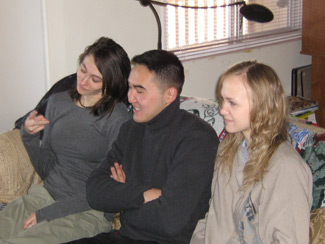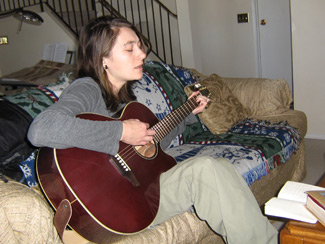|
|
It all began with Moses. God spoke to the old man. He said it was time to die. The years of discipline had passed. Now God’s chosen people would cross the Jordan River and take the land they could have had so many years before. Moses, however, could only look and die. Yes, he also took a final opportunity to speak to his rebellious but beloved people. Of all the advice he might have chosen to share, he called them together and said:
“Assemble the people, the men and the women and children and your alien who is in your gate, in order that they may hear, and learn and fear the Lord your God, and be careful to observe all the words of this law. So that their children, who have not yet been born, will hear and learn to fear the Lord your God, as long as you live on the land where you are about to cross the Jordan to possess it.” (Deuteronomy 31:12-13)
When Jesus came, Israel survived under the rule of Rome. Their challenge was to maintain their Jewish identity under the Roman oppression. They remembered the final command of Moses: Assemble everyone so that they will hear so that they will learn so that they will fear God so that they will obey God’s teaching so that their grandchildren and generations yet to be born will continue to be blessed and, in being blessed, will bless all the peoples of the world. Today, we too need to remember that God’s command always consists of “reasons and consequences”—God’s “so that…” These precepts are important to world transformation and provide the foundation on which churches can be planted, grown and reproduced anywhere in the world, within any people group and at any point in time. God chose them as his consistent and universal plan for his kingdom. They provide the key to worldwide spiritual intervention and transformation without the burden of cultural interference.
Jesus chose not to change any part of God’s command given through Moses. He led his followers to:
- worship God
- proclaim his salvation
- teach each other and those beyond
- minister to a sinful and needy world
- take care of each other
The command includes doing these things in such a way that even future generations will still do them the same way. Evidence of this command flows out of every story of every church discussed in the New Testament, both when they did obey and when they did not. New Testament writers taught these as the irreducible basics for Christ’s Church. They presented them as universal and time transcending. ![]()
Extending God’s Kingdom Worldwide
The question we face arises not from whether intervention, involvement and worldwide transformation must consume our lives as believers—but from how to accomplish the task. This writer has long insisted that no single method will prove sufficient. Those who boldly proclaim that one church model or another serves as the footprint for Christ’s Church in the twenty-first century miss the point of the examples that God left across his word for those who live today. God surely has many more ways for us to extend his kingdom and establish his Church worldwide than we have even thought, much less developed and implemented.
Where and how then do we even begin the process? Perhaps the answer comes in the very conditions in which we find the world. For instance, after fifty-nine years of religious repression in China, the year 2008 reveals a vast expansion of God’s kingdom. And where conditions are even harsher, with death stalking at every door knock, Christians and seekers meet regularly in a literal ring around the globe through the heart of radical Islam. Elsewhere, Cambodia now boasts perhaps four thousand evangelical home churches. India claims hundreds of new home churches each week, especially among the people groups most oppressed and intimidated by religionists and governments alike. Home-based churches are reproducing in hundreds of networks in nearly all the former Soviet republics in the rim around Russia.
Across Canada, where we live, isolated families seem less than encouraged to begin churches because they can likely never afford property, a building and a paid pastor. Dozens of tiny existing churches are spending their entire church lifespan feeling like failures because they never obtain all that they believe they need to be a successful and healthy church. In cities, it becomes more apparent every year that an average congregation can seldom afford the buildings and staff that will accommodate the present size of their group, much less future growth.
Sadly, many church and denominational leaders around the world exhibit a negative stance toward the concept of the home-based, lay-led church model. One such leader even declared to me that the home church may be biblical but it will not work, is not practical and is not effective in today’s world.
|
|
New Wave of Churches
However, God seems to be preparing the whole world for a vast new wave of churches that will be simple in organization, effective in teaching and evangelism and flexible enough to meet the needs of millions of people for whom other church models are not practical or possible. For many people, this forms the best model for today’s church.
For others, it may not be so. Yet, many people around the world will never find the Lord through cell or traditional churches. This is not because of a lack of effectiveness of those models in many settings, but simply because the lay-led home church is the best and perhaps the only way that many people will participate in a church. Other popular models are better for many people. The big three types of churches are not in competition. The autonomous, lay-led, home-based church is only one model among many that God has for the nations. It has problems and advantages just like any other model. Additionally, implementing this model demands big shifts in our concepts of “church.”![]()
Obvious Concept Shifts in Having Lay-led, Home-based Churches
The complete, healthy, autonomous Church of Jesus Christ has nothing at all to do with buildings. In the basic, literal definition of church as Jesus established it, neither size nor facilities exist. Some things seem quite difficult to get away from in our concept of “What is a church?” Two prominent ones are: (1) a church needs to grow numerically and (2) often as a consequence of that, a church needs to have the opportunity to worship together in numbers that require a building that is purchased, rented or borrowed.
Less Portentous yet Real Shifts in Having Lay-led, Home-based Churches
A “church” has nothing to do with constitutions, committees, organizations (within or beyond the church), choirs, praise teams, salaries, relationships to secular or religious governments, elected officers, designated office positions, budgets, long-range planning, conferences or any other extra-biblical trappings. Those things are needed and helpful in some church models. Not so in the home church.
The church is not about formally trained pastors per se. A church may have a “called” pastor, bishop or elder; however, the actual, literal, Greek wording in the New Testament has nothing to say about the “office” of the pastor. It is a function, not an office. Acts 20:28 reads within the conceptual image of “the shepherd who watches over” and 1 Timothy 3:1 renders it: “If one wants the overwatching.” Hierateia, “office” or hierarchy, is not there. It has not been changed from a different word—it is simply not there. The insertion of that word in translating demonstrates a pre-conceived concept. Jerome and other early translators had already made up their minds. In Romans 11:13, Paul claims “ministry,” not office. In Romans 12:4, it is “function” to describe the work of all of the members of the Church (including the bishops/elders). Only in Luke 1 and in Hebrews 8 do we find the actual word “office.” In all three cases it refers to the office of the priest (as opposed to, or different than, Christ’s declaration that all who are in him are priests). He declared the “office” of priest vacated and he, himself, the only high priest.
A church may have a “called” pastor, bishop or elder; however, the actual, literal, Greek wording in the New Testament has nothing to say about the “office” of the pastor.
Too much effort goes into searching for, placing and training leadership. When a home church accepts the idea that a trained pastor must be installed to lead a congregation, two strikes against that church exist. It probably cannot survive, at least as a reproducing home church. The only way that these small churches can possibly survive, thrive and reproduce is to share all the leadership among themselves within that church. And, in everything they do, it must all be so basic and simple that they can actually do it. To expect to someday have a “pastor,” as we conceive of that position, will set that church up to feel incomplete until they get one.
The greatest difficulty that exists in establishing, growing and reproducing home-based churches centers on the professionally-trained pastor-types. I am one of those and I have struggled with the idea that lay-persons can invite friends into their home, start a church with that group, win people to the Lord, lead the ordinances, teach and train each other and reproduce other similar churches with the capability of the same growth and reproduction. This reality may often appear more than many of us professional religionists can bear. ![]()
As full-time, called and trained ministers, our whole sense of security in ministry seems to demand churches that are visible, stable and with a considerable group to whom we can preach and be rewarded with a sense that they know us, love us and appreciate what we do. Our preparation and position in ministry is very much about us. There is something in us that fears a mobile, transient, flexible, Spirit-guided movement that constantly shifts, disappears, reappears and moves in ways utterly beyond our control.
A Biblical Look at Lay-led, Home-based Churches
Interestingly, Paul did apparently pastor several churches. However, in his writings, he spent almost no time thinking about those or discussing them. His primary focus as a trained leader and evangelist was as encourager, long-range teacher, counselor and sometimes harasser to many churches—probably mostly small, self-sufficient, home-based and lay-led congregations. And he refused to hold an official position with them or exert control over them in any way. Not only that, he even says to the small home churches already reproduced across Rome: “I myself am (totally) convinced, my brothers, that you (within) yourselves are (completely) full of goodness, complete in knowledge and (fully) competent to instruct one another.” (Romans 15:14, with Greek grammatical emphasis added).
There is something in us that fears a mobile, transient, flexible, Spirit-guided movement that constantly shifts, disappears, reappears and moves in ways utterly beyond our control.
Paul’s statement that concludes his fourteen chapters of doctrinal and practical counsel does not surprise us. We know that the entire book was not written to pastors or other selected leaders. Nor was it written to large congregations. Paul directed this profoundly theological writing to the lay members of dozens of small, autonomous home-based churches. And each operated, it appears, under a method of leadership shared by the entire body of lay-persons within each small church.
That biblical example of participation in leading by the whole group served as a key for the growth and reproduction of those churches. The same pattern continues to be as effective today. Our task is to create an understanding of the nature of the Church that will promote and not hinder the development of lay-led home churches with leadership participation by the whole group.
Help for starting, growing and reproducing these lay-led home-based churches can be found at: www.homechurchonline.com. All materials on the website are available for downloading, printing and sharing at no cost.



